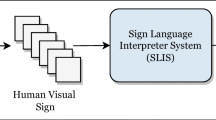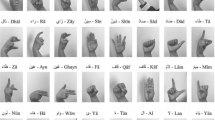Abstract
For those who are deaf or hard of hearing, sign language continues to be the preferred form of communication. As technology has advanced, systems that can automatically distinguish between spoken language and vision-based sign language have been created. This paper examines and identifies Arabic alphabet sign language (ArSLR). The Convolutional Neural Network (CNN) model is used by the system to visually recognize motions from the input sequence of hand photographs. We employed two datasets: the isolated words dataset for dynamic gestures given across multiple frames and the alphabet dataset for static gestures presented throughout a single frame. The suggested systems combine model training, feature extraction, and prediction. To boost performance, we concentrated on hyperparameter validation. The system’s accuracy has exceeded 98% after testing and comparing various metrics, which is comparative to other works utilizing the similar dataset.
Access this chapter
Tax calculation will be finalised at checkout
Purchases are for personal use only
Similar content being viewed by others
References
Sidig, A.A.I., Luqman, H., Mahmoud, S., Mohandes, M.: KArSL: Arabic sign language database. King Fahd University of Petroleum and Minerals, Saudi Arabia (2022)
Lim, K.M., Tan, A.W.C., Lee, C.P., Tan, S.C.: Isolated sign language recognition using convolutional neural network hand modelling and hand energy image. Multimedia University Jalan Ayer Keroh Lama, Malaysia (2019)
Luqman, H., Mahmoud, S.A.: Automatic translation of Arabic text-to-Arabic sign language (2018)
Neiva, D.H., Zanchettin, C.: Gesture recognition: a review focusing on sign language in a mobile context (2018)
Abdo, M.Z., El-Rahman Salem, S.A.: Arabic alphabet and numbers sign language recognition. Faculty of Engineering, Helwan University, Egypt (2015)
Naoum, R., Owaied, H.H., Joudeh, S.: Development of a new Arabic sign language recognition using k-nearest neighbor algorithm. J. Emerg. Trends Comput. (2012)
Hemayed, E.E., Hassanien, A.S.: Edge-based recognizer for Arabic sign language alphabet (ArS2V-Arabic sign to voice) (2010)
Assaleh, K., Al-Rousan, M.: Recognition of Arabic sign language alphabet using polynomial classifiers (2005)
Mohandes, M., Deriche, M.: Image based Arabic sign language recognition (2005)
Elons, A.S., Abull-Ela, M., Tolba, M.F.: A proposed PCNN features quality optimization technique for pose-invariant 3D Arabic sign language recognition (2013)
Al Mashagba, F., Nassar, M.O.: Automatic isolated-word Arabic sign language recognition system based on time delay neural networks: new improvements (2013)
Shanableh, T., Assaleh, K., Al-Rousan, M.: Spatio-temporal feature-extraction techniques for isolated gesture recognition in Arabic sign language (2007)
Shanableh, T., Assaleh, K.: Telescopic vector composition and polar accumulated motion residuals for feature extraction in Arabic sign language recognition (2007)
Ala, A.I., Hamzah Luqman, A.: Mahmoud Rybach: transform-based Arabic sign language recognition. King Fahd University of Petroleum and Minerals, Saudi Arabia (2017)
Assaleh, K., Shanableh, T., Fanaswala, M., Amin, F., Bajaj, H.: Continuous Arabic sign language recognition in user dependent mode (2010)
Albelwi, N.R., Alginahi, Y.M.: Real-time Arabic sign language (ArSL) recognition (2012)
Mohandes, M., Deriche, M., Liu, J.: Image-based and sensor-based approaches to Arabic sign language recognition. King Fahd University, Saudi Arabia (2014)
Author information
Authors and Affiliations
Corresponding author
Editor information
Editors and Affiliations
Rights and permissions
Copyright information
© 2023 The Author(s), under exclusive license to Springer Nature Switzerland AG
About this paper
Cite this paper
Bouhanou, I., Aboutabit, N. (2023). Arabic Sign Language Analysis and Recognition. In: Aboutabit, N., Lazaar, M., Hafidi, I. (eds) Advances in Machine Intelligence and Computer Science Applications. ICMICSA 2022. Lecture Notes in Networks and Systems, vol 656. Springer, Cham. https://doi.org/10.1007/978-3-031-29313-9_16
Download citation
DOI: https://doi.org/10.1007/978-3-031-29313-9_16
Published:
Publisher Name: Springer, Cham
Print ISBN: 978-3-031-28845-6
Online ISBN: 978-3-031-29313-9
eBook Packages: Intelligent Technologies and RoboticsIntelligent Technologies and Robotics (R0)




